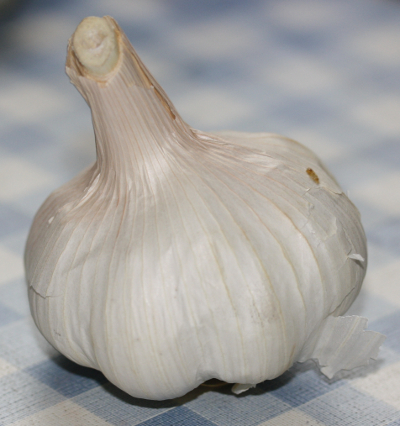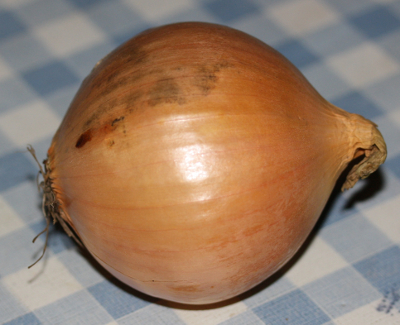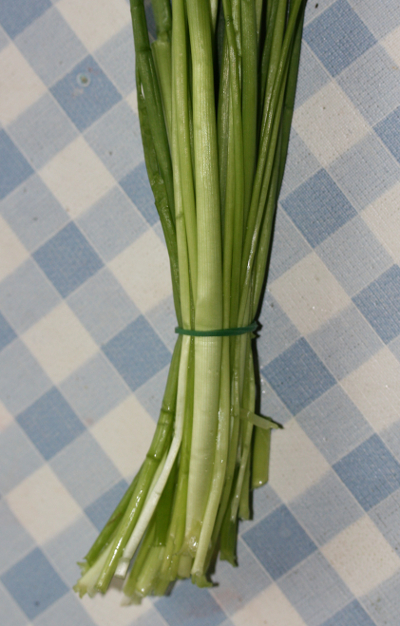Allium |

Garlic (Allium sativum)

Onion (Allium cepa)

Bunch of chives (Allium schoenoprasum)

Flowers of garlic (Allium sativum)
About 750 species, which initially occured mostly in the temperate zones of the northern hemisphere, today worldwide used as crop. The genus consists of perennial, herbaceous, bulbous or rhizomatous plants. The 1–15 leaves are thread-like, linear, linear-lanceolate, lingulate, egg-shaped or roundish. These mostly basal leaves forming an amplexicaule leaf sheat at the base of the scape, rarely petioles occur. In cross section, the leaves are flat or round, hollow or fleshy. Leaves in the blooming period mostly wilted. The often leafless scape is hollow or solid, round or flattened, erect or ascending.
The terminal, umbel-like inflorescence, which is initially enclosed by one or two membranous, beaked bracts, bears either only flowers, only bulbils, or a combination of both. The flowers mostly are hermaphroditic, stalked, white, yellow, purple, bluish or reddish and have 6 identically shaped petals which are arranged in two circles and which can be fused at the base. The 6 stamens are usually wider at the base and grown together. The inferior ovary is composed of 3 carpels and bears a stylus with a capitate or 3-lobed stigma.
After insect pollination 3-loculate capsules are formed with 6 or more black, obovate, rhombic or spherical seeds.
| Floral formula: |
| * P3+3 bzw. P(3+3) A3+3 bzw. A(3+3) G(3) inferior |
Alliin, isoalliin and the alliinase
These two substances, as well as the enzyme, are responsible for the garlic- or onion-like smell and taste of different Amaryllidaceae. Alliin, a sulfur-containing amino acid, included in e.g. garlic or ramsons, is located in the cytoplasm. The corresponding enzyme alliinase can be found in the vacuoles. If the tissue is damaged, so the alliinase cleaves the alliin into two different molecules, including allylsulfenic acid. Afterwards two molecules allylsulfenic acid condense to form a compound called allicin, which has the typical garlic flavor.
In onions, chives, leeks etc. there is a molecule similar to alliin in the cell plasma, which is called isoalliin. By a alliinase mediated reaction propenesulfenic acid is generated. After elimination of water syn-propanethial s-oxide is formed - the lacrimatory factor. These mechanisms are protective functions of the plant against herbivores, but they have not a deterrent to humans.
Useful and ornamental plants
Many Allium species be used in the kitchen: Garlic (Allium sativum), onion (A. cepa), chives (A. schoenoprasum), leek (A. porrum), Welsh onion (A. fistulosum), wild leek (A. ampeloprasum) and ramsons (A. ursinum). In addition, there are numerous hybrids and ornamental leeks for cultivation in the garden.
Historical publications
Theophrastus (371–287 B.C.) already knew several species of the genus such as leek, squill, onions and garlic. He described them, enumerated several varieties and gave instructions for their cultivation. Also Pliny (approx. 23–79 AD.) acted similarly, he gave instructions for their conservation and listed a variety of medicinal effects. Dioscorides (1st century AD.) focused on the medical applications and treated leek, onion, garlic, Welsh onion and round-headed leeks.
Hildegard of Bingen (1098–1179) wrote about Welsh onions, they would not harm healthy people, but for the sick ones, they should be cooked. Garlic, however, must be eaten raw in any case, but moderately, so that the blood would not warm up excessively. Leeks neither raw nor cooked would be good for sick people. About the shallot she wrote, that it was cold and toxic and could only be tolerated if it was previously pickled in wine. When cooked it would produce stomach pain. The onion should be only used if cooked - then it would be good against fever and gout.
Leonhart Fuchs (1501–1566) treated garlic, wild garlic, field garlic and ramsons in the same chapter. In Greek the genus would be called Scorodon and in Latin Allium. He recommends the herbs, among other, against flatulence and worms. Leeks and chives he have also been dealt together. They would cause flatulence and made hazy eyes. He recommends it, however, against jaundice and dropsy.
Meaning of the species name
- vineale: lat. vinealis = growing on vineyards
Interesting notes
-
Most alliums are non-toxic and edible. Some, however, like Allium caspium contain toxic saponins.
-
Not only among the ornamental plants, also among the crops of the genus, there are hybrids, such as the garlic chives or a cross between Welsh onion and kitchen onion.